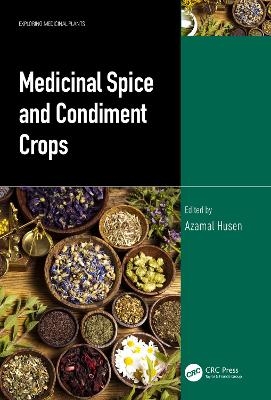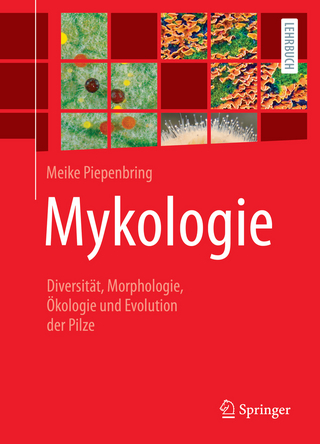
Medicinal Spice and Condiment Crops
CRC Press (Verlag)
978-1-032-46947-8 (ISBN)
Spices are used in small quantities to add flavor, aroma, color, and texture in food preparation. However, spices and condiments have also been recognized as having medicinal value. They have been used traditionally as curative and preventive agents, the bioactive compounds obtained from these plants are used in herbal drug formulations in modern times. Medicinal Spice and Condiment Crops provides a comprehensive overview on the medicinal properties of spices and condiments with focus on various phytochemicals derived from them.
KEY FEATURES:
Examines spices and condiments with respect to their biology, diversity, distribution, and pharmacological values
Explores the scientific validations of the therapeutic potentials of spice and condiment plant species
Discusses the bioactive agents involved in alleviating symptoms of cardiovascular disease, cancer, diabetes, ulcers, skin disorders, and neurodegenerative diseases
Explains specific medicinal features of spice and condiment-producing plant species inspiring research, discovery, and safe herbal drug formulation
A volume in the Exploring Medicinal Plants series, this book is useful for plant scientists, economic botanists, those who work with herbal and complementary medicine, as well as people working in the pharmaceutical industry.
Dr Azamal Husen is presently working as a Professor at Sankalchand Patel University, Visnagar, India, and is an Adjunct Professor at Graphic Era (Deemed to be University), Dehradun, Uttarakhand, India. He is also working as a Visiting Professor at University Putra Malaysia, Selangor, Malaysia. Previously, he served as a Professor and Head of the Department of Biology, University of Gondar, Ethiopia; and he worked as a Foreign Delegate at Wolaita Sodo University, Wolaita, Ethiopia. He also worked as a Visiting Faculty of the Forest Research Institute and the Doon College of Agriculture and Forest at Dehradun, India. His research and teaching experience of 25 years encompasses biogenic nanomaterial fabrication and applications; plant responses to nanomaterials; plant adaptation to harsh environments at the physiological, biochemical, and molecular levels; herbal medicine; and clonal propagation for the improvement of tree species. Dr Husen has conducted several research projects sponsored by various funding agencies, including the World Bank (FREEP), the National Agricultural Technology Project (NATP), the Indian Council of Agriculture Research (ICAR), the Indian Council of Forest Research Education (ICFRE), and the Japan Bank for International Cooperation (JBIC). He received four fellowships from India and a recognition award from the University of Gondar, Ethiopia, for excellent teaching, research, and community service. Husen has been on the editorial board and the panel of reviewers of several reputed journals published by Elsevier, Frontiers Media, Taylor & Francis, Springer Nature, RSC, Oxford University Press, Sciendo, The Royal Society, CSIRO, PLoS, MDPI, John Wiley & Sons, and UPM Journals. He is on the advisory board of Cambridge Scholars Publishing, UK. He is a Fellow of the Plantae group of the American Society of Plant Biologists, and a member of the International Society of Root Research, Asian Council of Science Editors, and INPST. To his credit are over 250 publications, and he is Editor-in-Chief of the American Journal of Plant Physiology. Dr Husen is also working as Series Editor of Exploring Medicinal Plants (Taylor & Francis, USA); Plant Biology, Sustainability, and Climate Change (Elsevier, USA); and Smart Nanomaterials Technology (Springer Nature, Singapore). He has been achieved the distinguished honour of being recognized as one of the “World’s Top 2% Scientists” for 2022, and again for 2023 by Stanford University, USA. This recognition has also been prominently featured in the Elsevier Data Repository.
1. Diversity and geographic distribution of spices and condiments plant species
2. Biology and genetic improvement of spices and condiments plant species
3. Sustainable techniques for the harvest and conservation of spices and condiments plant species
4. Tissue culture of medicinal spice and condiment crops for mass propagation
5. Ethnobotany of Spices and Condiment Plant Species
6. Nutritional and chemical value of spices and condiment plant species
7. Antioxidants from spices and condiments plant species and their applications
8. Allspice (Pimenta dioica)
9. Aniseed (Pimpinella animus)
10. Asafoetida (Ferula assafoetida)
11. Black cumin seeds (Nigella sativa)
12. Black pepper seeds (Piper nigrum)
13 Cinnamon bark (Cinnamomum species)
14 Clove buds (Syzygium aromaticum)
15. Coriander Leaves and Seeds (Coriandrum sativum)
16. Cumin seeds (Cuminum cyminum)
17. Fenugreek seed (Trigonella foenum-graecum)
18. Garlic bulb (Allium sativum)
19. Ginger rhizome (Zingiber officinale)
20. Mustard seeds (Brassica species)
21. Nutmeg seeds (Myristica fragrans)
22. Saffron flower (Crocus sativus)
23. Turmeric rhizome and leaves (Curcuma longa)
| Erscheinungsdatum | 21.04.2024 |
|---|---|
| Reihe/Serie | Exploring Medicinal Plants |
| Zusatzinfo | 37 Tables, black and white; 14 Line drawings, black and white; 39 Halftones, black and white; 53 Illustrations, black and white |
| Verlagsort | London |
| Sprache | englisch |
| Maße | 178 x 254 mm |
| Gewicht | 902 g |
| Themenwelt | Medizin / Pharmazie ► Allgemeines / Lexika |
| Naturwissenschaften ► Biologie ► Botanik | |
| Weitere Fachgebiete ► Land- / Forstwirtschaft / Fischerei | |
| ISBN-10 | 1-032-46947-1 / 1032469471 |
| ISBN-13 | 978-1-032-46947-8 / 9781032469478 |
| Zustand | Neuware |
| Informationen gemäß Produktsicherheitsverordnung (GPSR) | |
| Haben Sie eine Frage zum Produkt? |
aus dem Bereich


